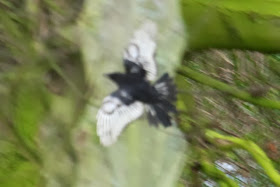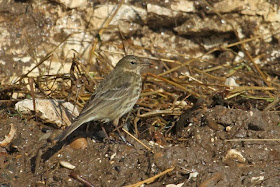On Friday & Tuesday we went to Seweby. On Tuesday the tide was just going out, so we walked round the hall grounds first. The first bird we really tracked down was a Treecreeper. Unfortunately, it chose a yew tree to climb up, so was quite difficult to see especially for prolonged views, although I think everyone managed to see it eventually. Rather surprisingly the Mistle Thrush was nowhere to be seen, nor were the Great Spotted woodpeckers. However, one bird which didn't let us down was a very confiding male Goldcrest. He flitted about, singing from one tree or another before we moved on and left him in peace. There was very little on the golf course, but Rose spotted an immature Herring Gull paddling. This is when a gull seems to run on the spot. It is thought that this action simulated the falling of heavy rain & the worms leave their burrows to escape the possible flooding only to end up in the bill of the waiting gull.
Male Goldcrest (c) 2014 Chris Cox
Goldcrest (c) 2014 Maggie Bruce
On the way to the beach we noticed a "Pied Crow" flying around the animal enclosures. This is a bird that relied on artificial food sources when it was moulting, resulting in this leucistic appearance. It almost looks like a different species. If only he'd followed some his cousins down on the beach. Their more varied diet of molluscs ensured that their feathers were full of melanin and were completely normal.
"Pied" Carrion Crow (c) 2014 Maggie Bruce
Record Shot of Flying "Pied" Crow (c) 2014 Maggie Bruce
Bog Standard Carrion Crow (c) 2014 Chris Cox
Oystercatcher in winter plumage (c) 2014 Maggie Bruce
Ditto
By 11 o'clock the tide was starting to recede so we went down onto the beach. Unlike Friday there were dozens of birds on the beach. There were noisy Oystercatchers as always, but also bathing Turnstones, and plenty of nearby Redshank. Then David, who had been scanning the foot of the cliff, reported a Rock Pipit, and sure enough ear eventually located it on the top of one of the seaweed heaps at the bottom of the cliff. There was also a very pale Pied Wagtail in the area.
Turnstones (c) 2014 Chris Cox
Turnstone (c) 2014 Maggie Bruce
Turnstone with a stump (c) 2014 Maggie Bruce
Redshank (c) 2014 Chris Cox
Oystercatcher in Breeding Plumage (c) 2014 Chris Cox
Rock Pipit (c) 2014 Chris Cox
Rock Pipit (c) 2014 Maggie Bruce
Pied Wagtail (c) 2014 Maggie Bruce
Although we kept scanning the skies, this was one day when there was no sign of any birds of prey.
Dunlin (c) 2014 Chris Cox
Flying Oystercatchers (c) 2014 Chris Cox
Rock pipit (c) 2014 Maggie Bruce



















No comments:
Post a Comment